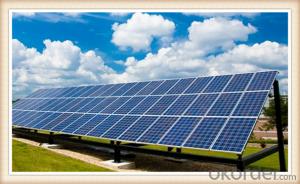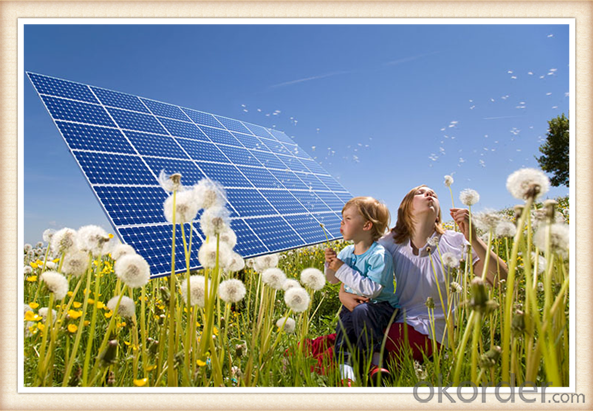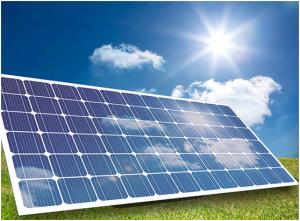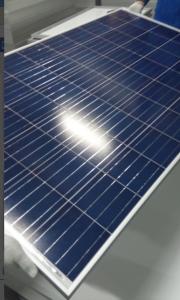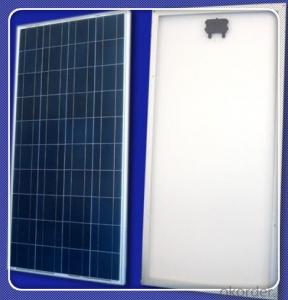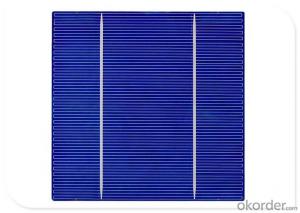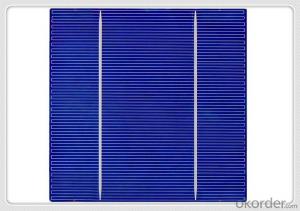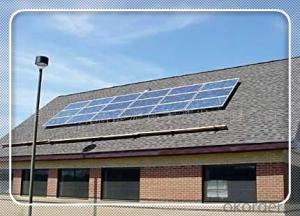Solar Panels Vic 100w Efficiency Photovoltaic Chinese Solar Panels for Sale 5-200w
- Loading Port:
- China main port
- Payment Terms:
- TT OR LC
- Min Order Qty:
- 10000 watt
- Supply Capability:
- 100000 watt/month
OKorder Service Pledge
OKorder Financial Service
You Might Also Like
Specification
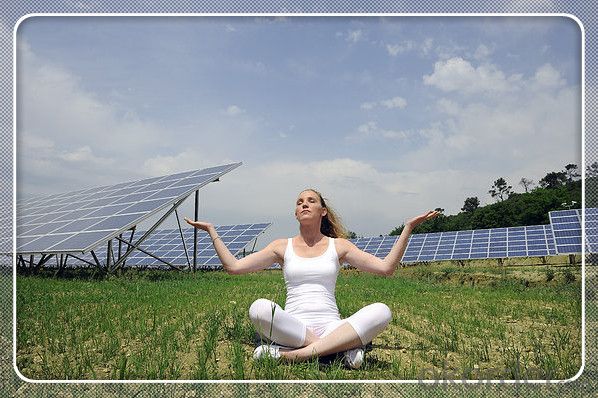
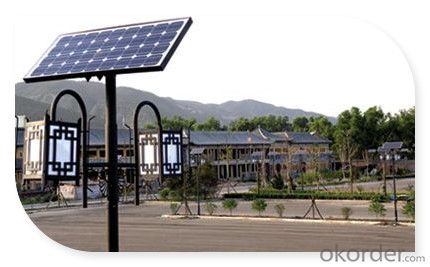
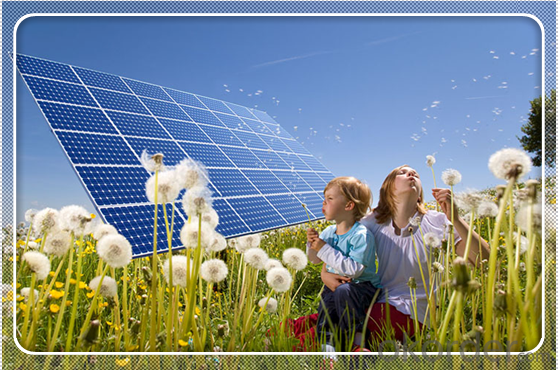

Solar Module Introduction
Solar Module is the core part of solar PV power systems, also is the highest value part of it. The function of Solar Module is to convert the sun's radiation to electrical energy, or transfer it to battery and store in it, or to drive the load running.
The Product has been widely used in space and ground, it mainly used for power generation systems, charging systems, road lighting and traffic signs areas. It could offer a wide range of power and voltage, and with high conversion efficiency, and long service life.
Solar modules use light energy (photons) from the sun to generate electricity through the photovoltaic effect. The majority of modules use wafer-based crystalline silicon cells or thin-film cells based on cadmium telluride or silicon. The structural (load carrying) member of a module can either be the top layer or the back layer. Cells must also be protected from mechanical damage and moisture. Most solar modules are rigid, but semi-flexible ones are available, based on thin-film cells. These early solar modules were first used in space in 1958.
Electrical connections are made in series to achieve a desired output voltage and/or in parallel to provide a desired current capability. The conducting wires that take the current off the modules may contain silver, copper or other non-magnetic conductive transition metals. The cells must be connected electrically to one another and to the rest of the system. Externally, popular terrestrial usage photovoltaic modules use MC3 (older) or MC4 connectors to facilitate easy weatherproof connections to the rest of the system.
Secification
Model Type | |
Peak Power-Pmax(W) | 5-200W |
Open Circuit Voltage-Voc(V) | 44.2 |
Maximum Power Voltage-Vmp(V) | 36 |
Short Circuit Current-Isc(A) | 5.4 |
Maximum Power Current-Imp(A) | 5 |
Maximum System Voltage | 1000V DC |
Maximum Series Fuse Rating | 10A |
Power Tolerance | -1~+3% |
Temperature Coefficients of Pmax | -0.45%/℃ |
Temperature Coefficients of Voc | -0.348%/℃ |
Temperature Coefficients of Isc | 0.031%/℃ |
Nominal Operating Cell Temperature | 44.5±2℃ |
Standard Testing Condition(STC) | Irradiance:1000W/m²;Temperature:25℃;AM=1.5 |
Qualification Test Parameters | |
Operating Temperature | -40℃~+85℃ |
Storage Temperature | -40℃~+85℃ |
Pressure Bearing | ≥5400Pascal/m² |
Wind Bearing | ≥5400Pascal/m² |
Mechanical Characteristics | |
Cell Size | Mono 125*125mm±0.5 |
No.of Cells | 72pcs(6*12) |
Dimension | 1580*808*40mm |
Weight | 15.5Kg |
Glass | 3.2mm High Transmission,Low Iron |
Frame | Anodized Aluminum Alloy |
Junction Box | IP65Rated |
Internal Diodes | 3 Bypass Diodes |
Cable | 1*4.0mm² Length 900mm |
Images
Packing & Shipping:
We have rich experience on how to pack the panels to make sure the safety on shipment when it arrives at the destination.
The normal size is packed by 25pcs/ carton / pallet. Paper carton for FCL shipping and wood carton for LCL shipping.
Warranty:
For c-Si panel: 25years output warranty for no less than 80% of performance, 10 years output warranty for no less than 90% of performance. Free from material and workmanship defects within 5 years.
For a-Si panel: 20 years output warranty for no less than 80% of performance, 10 years output warranty for no less than 90% of performance. Free from material and workmanship defects within 2 years.
FAQ:
(1)What price for each watt?
It depends on the quantity, delivery date and payment terms.
(2)What is your size for each module? Can you tell me the Parameter of your module?
We have different series of panels in different output, both c-Si and a-Si. Please take the specification sheet for your reference.
(3)Can you provide the peripheral products of the solar panels, such as the battery, controller, and inverter? If so, can you tell me how do they match each other?
Actually we are only manufacturer of solar panels, but we could try to source them for you in China if you need. We could provide you an optimal system design to instruct you how to install.
(4)Do you have the CE, TUV, UL Certification?
We’ve already passed all the tests, and any certificate is available.
(5)Have you ever sold your products to companies in my country?
Of course, we have customers in all general PV markets, but I think we should expand our market share along with the market growth.
(6)When did your company set up? You are a new company, how can I believe your quality?
We entered into Solar PV industry in 2005, now we have several plants in manufacturing of a-Si and c-Si panels, and our capacity is 220MW per year. Till now we have already passed all the tests by authorized laboratories, e.g. TUV, VDE, UL.
(7)Can you help us install the module if we cooperate with you?
We haven’t entered into installation sector, but we have the plan in near future.
(8) How do you pack your products?
We have rich experience on how to pack the panels to make sure the safety on shipment when it arrives at the destination.
(9) Can you do OEM for us?
Yes, we can.
(10)Can we visit your factory?
Surely, I will arrange the trip basing on your business schedule.
- Q: What is the efficiency of modern solar panels?
- The efficiency of modern solar panels typically ranges between 15% and 22%, with some high-end panels reaching efficiencies of up to 23-24%. However, it is important to note that efficiency can vary depending on factors such as the brand, technology used, and environmental conditions.
- Q: For a computer technology project we are using solar panels and trying to see different methods that will increase the output of solar power from these panels. For now, we have got polymer stickers and mirrors. Are there any more methods, or information that increase the solar power? Please and thank you :)
- I agree with the other answers; . Different angles to attract more light. 2. Cooling the panels. Just make sure you have a control set up. As for the cooling I'd say if the aim was overall energy efficiency then this method would not work unless you could devise a cooling method that didn't use any electricity.
- Q: How long does it take to recoup the investment in solar panels?
- The time it takes to recoup the investment in solar panels varies depending on several factors, such as the cost of the panels, the amount of energy they generate, the electricity rates, and any available incentives or tax credits. On average, it can take anywhere from 5 to 15 years to recover the initial investment. However, with decreasing panel costs and increasing energy savings, the payback period is becoming shorter, making solar panels a more attractive and financially viable option for many homeowners and businesses.
- Q: Hi. I have been looking into getting solar panals but I only want them for one room. See, we're expanding the house by adding a basement, the basement isn't going to be that big but we wanted to have solar energy for the basement only. Could anyone give me a rough estimate on the cost of solar panals for my basement?
- Only after you give an estimate of the power consumption you will have in the basement. Obviously you do not have a clue about solar panels or their usage. Suggest you find a book and start reading.
- Q: I have a home in Manchester Tn and we have been slowly remodeling the home. It is about 200 sq ft of living space. Our normal electric bill is about 50 a month. We would like to add some solar panels to the home to help reduce the amount of the bill. How many panels do I need and what would be the cost? I am not trying to go completely of the grid but I would like to start somewhere and maybe over the years be able to add. What is your recommendation for a reasonable cost of under 2 to 3 k??
- you need to read and ? your elect co they will help you with survey of your elect use and how to lower bill . for free also read about solar panels and how to use and install bg makes good panels but panels only small part of cost invertor and controler and batterys bigger cost the real expense is panel and controler for panels to to grid connection as per nec is very expensive more than 2 for most 00 or 200 amp service you would better to change to demand type warer heater and flouresent lights and upgrade isullation depending on how you heat house and your area heat pump etc but call your elect co for engergy survey
- Q: im making an energy efficiant house for science class and i need to price the house. im putting solar pannels on the roof and would u please tell me how much they are per like 2 sq. feet of a pannel?
- Completely self-efficient and autonomous??? Forget it. Too expensive. It's only worth if you use like 8 lights (2-20w) about 4 hours a day, a fridge, a tv about 4 hours/day and basically nothing else or a few low consume stuff. Forget about microwaves, dryers, or other stuff. Too much watts. And that would cost you no less than 5000-6000$. You need panels (about 4 or 6 20w would suit maybe), 2 batteries (about 600Ah at least), inverter(500w/24v) and a regulator, lets say a 30A one. Just stick to normal energy supply. A single 20w panel may cost about 750$ at least.
- Q: Parents planning on buying some solar panels for our house down in Dubai it really hot there I'm currently living in Canada, anyways I'm wondering how many solar panels and volts ill need to light up a 2400sq ft. House? Please leave you're suggestions below!
- It's not really the solar panels that power the house, they charge a battery bank and there's an inverter that jumps the battery power up to household current level. If you start getting into more expensive systems, they can sense when the batteries are full and start diverting power into the local electric grid. Some places the electric company is required to pay you for generating current, other places tell you tough luck. I suggest looking on OKorder or something at some of the home solar kits on sale there and look at how large a house they are rated for to get an idea of how big a system you're going to need. I don't know if you have access to the power bill history of the house you're getting in Dubai, but the power company there might be able to provide you with a history of average kW hours the house consumes. A 2400 sqft house with a gas stove and a gas water heater and wood heat is going to consume far less electricity than a house with all electric appliances and the consumption history of an individual house should reflect that so you can buy appropriately.
- Q: I want to build a Solar Panel at home.Where can I find possibilities for Selfmade Solar Panels
- that will sell a ready-made panel for less than that. Note that when someone puts up free instructions, they usually have lots of pictures of themselves and what they made, step-by-step. What I have noticed in all of the review sites for solar guides is that they never have a picture of what they made, in spite of their claims to have tried the guide. At best, all I see is stock pictures from the guide.
- Q: Its cloudy out and i have a solar panel that has 3, .5 volt cells But how do i charge it without sun any other ways?
- For the best answers, search on this site https://shorturl.im/awXJ0 The charge controller will protect the battery. You might want to think about getting a fuse.
Send your message to us
Solar Panels Vic 100w Efficiency Photovoltaic Chinese Solar Panels for Sale 5-200w
- Loading Port:
- China main port
- Payment Terms:
- TT OR LC
- Min Order Qty:
- 10000 watt
- Supply Capability:
- 100000 watt/month
OKorder Service Pledge
OKorder Financial Service
Similar products
Hot products
Hot Searches
Related keywords
